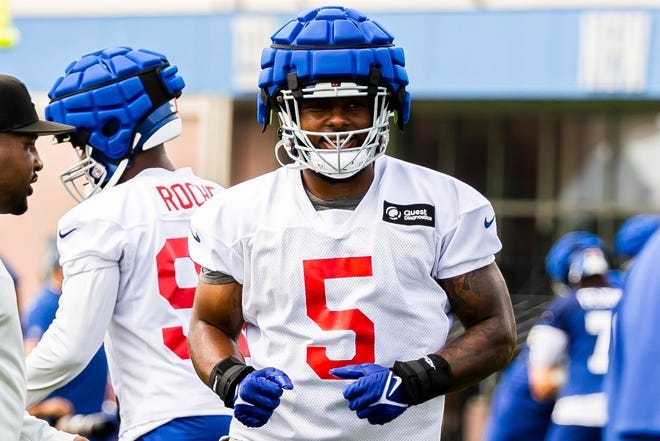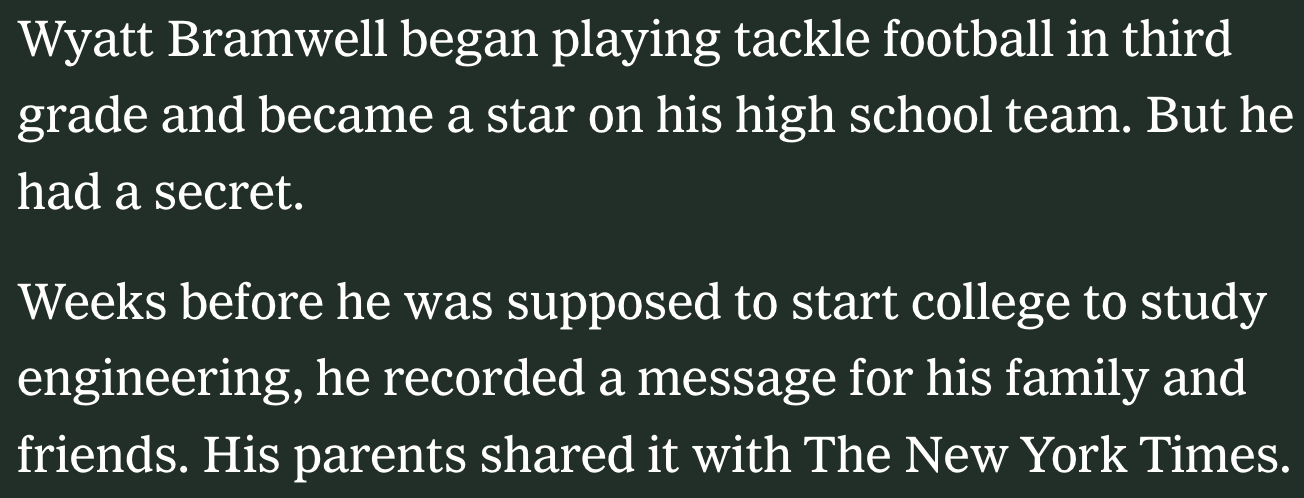Traumatic Brain Injuries and football- Your passion shouldn't kill you
Research is showing that tackle football is leading to the deaths of children at ever-younger ages. Is America's favorite sport worth the risk?
Watching and listening to Wyatt Bramwell’s video is an exercise in the surreal. He seems like a typical teenager. He speaks in the usual tone and cadence of an intelligent and articulate young man, yet it’s clear Bramwell knows something is terribly wrong. He’s not sure what it is, but he’s got a pretty good idea of what it might be. After years of playing tackle football, he fears he may have CTE (chronic traumatic encephalopathy).
CTE is the result of repeated traumatic brain injuries (TBI), normally concussions. More recent research has shown that TBIs that don’t result in concussions can have a cumulative effect that may result in CTE over time.
CTE can only be diagnosed post-mortem. Wyatt Bramwell knew this, which is why he shot himself in the chest. He wanted his brain to be intact so it could be donated to Boston University for continuing research on CTE.
Once upon a time, stories about CTE were limited to professional football players. Many of us have heard names like Mike Webster, Dave Duerson, Junior Seau, and others who’d suffered so many TBIs over the years before much was known about the potential for long-term brain damage.
Recent research has shown that children who start in youth football can suffer CTE by the time they graduate from high school. Many parents aren’t aware of the potential for long-term damage to a child’s developing brain. Most youth and high school leagues don’t have spotters in press boxes high above the action to look for potential head injuries like the NFL. And most coaches and parents aren’t trained to spot potential head injuries.
The New York Times did an impactful and incredibly heart-wrenching interactive report on how TBIs are impacting football players at ever-younger ages. And so the question becomes how to protect our children’s brains in an era when players continue to become bigger, faster, and stronger.
How do we prevent tragic outcomes like Wyatt Bramwell? He wasn’t sure what was happening to him, but he knew the voices in his head weren’t a good thing. He also knew that he couldn’t take it anymore. How do we preserve the game America loves without sacrificing young brains and lives for it?
One idea has shown promise but has struggled to gain traction, if only from a fashion standpoint. The Guardian Cap is a soft-shell helmet that’s worn on the outside of a traditional hard-shell helmet. Thus far, it has proven successful in reducing impacts and the severity of blows, particularly to the head.
Guardian XT reduces impact up to 33%
Guardian NXT (NFL version) reduces impact an average of 10%
Addresses the impact severity of blows for offensive linemen, defensive linemen, linebackers, and tight ends
Pads blows to knees, hands, abdomen, etc. during inside runs and position drills

The NFL has mandated that Guardian caps be worn during preseason camps. While not having the level of physical contact of games, practices can and sometimes do simulate game speed and physicality, increasing the potential for TBIs.
The NFL says that they can reduce concussions by up to 10% if one player involved in a collision is wearing one of them and up to 20% if both players involved in a collision have them on. For the last three seasons, before the Guardian Cap mandate began, the NFL has reported 30 documented concussions per year during preseason practices.
Guardian Sports, the company that makes the caps, initially designed them thanks in part to funding granted by the NFL in pursuit of reducing the number of head injuries suffered in practice.
Typically, as teams ramp up the amount of contact in training camps, the number of head injuries rises. Jeff Miller, the NFL's Executive Vice President for player health and safety, said in March that they settled on the timeframe for requiring Guardian Caps, “because that's where we see the greatest concentration of helmet impacts during the course of the year. Larger rosters, more frequent contact practices, so we hope that there will be an injury savings there for our players.”
When the NFL mandated that players would wear Guardian Caps during training camp in 2022, the announcement wasn’t greeted with unbridled enthusiasm. Many players saw the Guardian Caps as a fashion faux pas. In short, they thought the caps looked ridiculous.
J.J Watt, a star defensive lineman who retired after the 2022 season, spoke for a lot of NFL players:
Arizona Cardinals defensive lineman and three-time defensive player of the year J.J. Watt is not a fan of wearing the Guardian Cap during training camp and he wasn't shy in sharing his thoughts on Friday.
"I mean, I think you know what I think of the Guardian Caps we're wearing," Watt said with a chuckle.
Watt didn't hesitate when he was asked if he could feel the difference while wearing the padded shell that attaches to the outside his helmet.
"You feel like a bobblehead," Watt deadpanned. "Like you're gonna fall over. I'll probably get fined for this. This is great. You guys are just screwing me to start out the whole year. There's 15 grand gone."
The Guardian Cap is required for all offensive linemen, defensive linemen, tight ends and linebackers during training camp practices until the second preseason game. In a release, the NFL said that period of camp is when the league noticed the "greatest concentration of helmet impacts."
Despite his comments, Watt understood the thought process behind the league mandating the Guardian Caps. It was the fashion aspect he objected to, which is understandable for those used to the iconic look of the hard-shell helmet. There are few things in sports as iconic and symbolic as a hard-shell football helmet.
I grew up playing tackle football, and I still fondly remember the thrill of getting a helmet issued to me on the first day of practice. There was something magical about slipping it over my head, squeezing it over my ears, feeling its weight, grabbing the face bar, and hearing the sound when I slapped the hard shell. Putting on a football helmet is a rite of passage for many American boys. It means that you’re entering the world of men and are worthy of waging mortal combat on dirt and grass under the lights on Friday nights.
And someone wants to put a Guardian Cap on that and make players look like giant bobbleheads? What a great way to emasculate them, eh?
Of course, therein lies the conflict between the threat to players’ brains and making them look and feel silly.
Are we men…or are we giant bobblehead dolls??
It’s one thing for professionals to put their brains at risk. They’re adults; by the time they reach the NFL, they’re well aware of the risks they assume when they step between the lines. It’s quite another for a herd of nine-year-olds to run into each other at full speed play after play for a few games each season.
No one thinks much of those collisions, but it turns out that the damage from them can accumulate over the years. In a worst-case scenario, a parent may get a call like the one Wyatt Bramwell’s parents received.
Don’t get me wrong; I love football. I still watch it, and I’m still a rabid Minnesota Vikings fan (yes, I still live with the same disappointment I have year after year after year). That said, I can’t watch a game without thinking about the impacts- what a friend who’s a former NFL player once described as an automobile accident on every play. And I can’t help but ask myself how many players will lose their brains (or lives) to CTE.
And I find myself wondering if it’s worth it…not that I can tear myself away from the television.
(All of my posts are now public. Any reader financial support will be considered pledges- support that’s greatly appreciated but not required to get to all of my work. I’ll trust my readers to determine if my work is worthy of their financial support and at what level. To those who do offer their support, thank you. It means more than you know.)









I'd be curious to see how the teams and players reacted when the leagues mandated the change from soft caps to hard shell helmets.